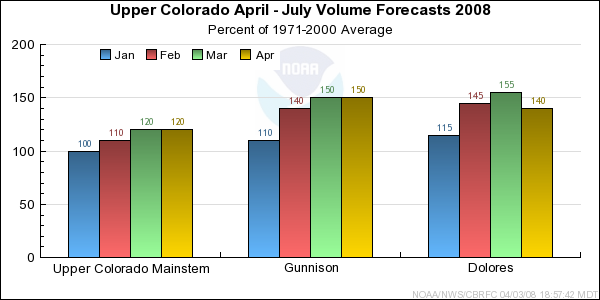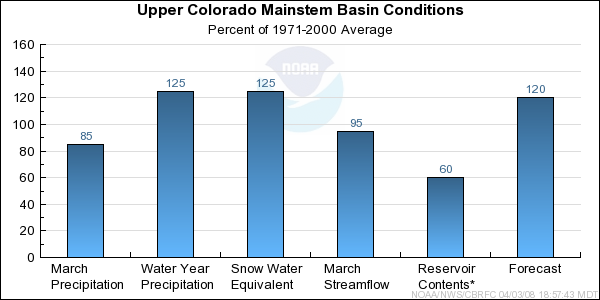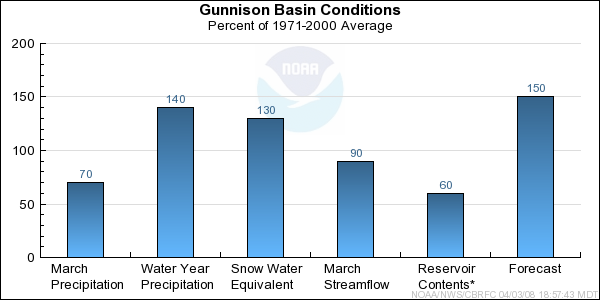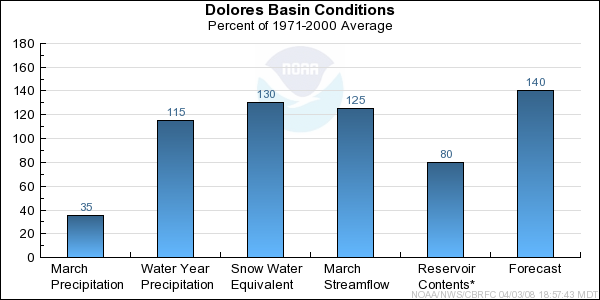Upper Colorado Water Supply Outlook, April 1, 2008
Note: This publication is scheduled for revision. If you have feedback on content, format, or publication frequency, please contact us.
Contents
Upper Colorado Summary
March was a much drier month than we have seen so far this winter in the Upper
Colorado Basin, especially in the Dolores River Basin which received just 35%
of average precipitation during March. The headwaters of the Gunnison and
Upper Colorado mainstem basins received close to normal precipitation for the
month, while the rest of the areas in those basins received between 40% and
80% of average precipitation. As a result, median forecasts for the April
through July runoff volumes dropped 15% in the Dolores Basin and remained
steady in the Gunnison and Upper Colorado mainstem basins.

*Median of forecasts within each basin.
Upper Colorado Mainstem Basin Conditions
The Upper Colorado mainstem basin as a whole received about 85% of the average March
precipitation, but this was not distributed uniformly across the basin. The
headwaters on the southern side of the basin above Glenwood Springs received
near normal precipitation for the month while areas below this received closer
to 50% of average precipitation. Temperatures were a bit on the cool side for
the month overall, as they have been for most of the winter. As a result of
these near normal precipitation and temperature conditions in the higher
elevations during March, the snow water equivalent remained above normal for
this time of year at 125% of average on April 1st; this is only a 5% drop from
the March 1st percent of average. The Roaring Fork basin snow water equivalent
remains the highest in the basin at close to 150% of average. Model soil
moisture is still near to just below average at this time as the runoff gets
ready to start. Current meteorological models are indicating a chance for
continued unsettled weather during the first half of April over western
Colorado. If this occurs, there is potential for additional snowpack
accumulation, or at the very least little loss of snowpack due to melt.
With all this in mind, there were minimal changes made to the forecasts from
last month with just a few points in the Eagle and Roaring Fork basins, as
well as affected downstream points, being raised slightly. The April through
July streamflow forecasts now range between 100% and 150% of average.

* Percent usable capacity, not percent average contents.
Click for multi-month Graph.
Gunnison Basin Conditions
Precipitation in the Gunnison Basin varied for the month of March. In the northeast portions of the basin, precipitation was around average. For the rest of the basin, precipitation was below average. April 1st percent of average snow water equivalent in the Gunnison Basin ranges from 105% to 160%. On average, this is a 10% reduction from the March 1st percent of average snow water equivalent. However, overall the snowpack is 130% above the average seasonal maximum accumulation.
Streamflow in the Gunnison Basin was 90% of normal for March. Modeled soil moisture states are around average, except for the North Fork of the Gunnison which is below average. April through July volume forecasts in the Gunnison Basin remained steady except for East River and Gunnison River at Gunnison, where there was a slight increase, and Paonia Reservoir, where there was a slight decrease. Volume forecasts range from 135% to 160% of average.

* Percent usable capacity, not percent average contents.
Click for multi-month Graph.
Dolores Basin Conditions
The Dolores Basin saw monthly precipitation well below average for March. April 1st percent of average snow water equivalent in the Dolores ranges from 110% to 140%. This is a 30% reduction from March 1st percent of average snow water equivalent. However, the cool temperatures in March allowed the snowpack to remain higher than the average seasonal maximum accumulation at 120%.
Streamflow in the Dolores Basin was 125% of average for March. Modeled soil moisture conditions in the basin remain around average. With the well below average precipitation for March, the April through July volume forecasts in the Dolores Basin have been reduced. The forecast for McPhee Reservoir is now 450 kaf. However, this is still above the average of 320 kaf. Volume forecasts in the Dolores Basin range from 135% to 150% of average.

* Percent usable capacity, not percent average contents.
Click for multi-month Graph.
Differences between the full period forecasts and the residual forecasts may not exactly equal the actual observed volumes due to rounding conventions (see Definitions section).
Precipitation Maps


Hydrologist: Brenda Alcorn, John Lhotak







